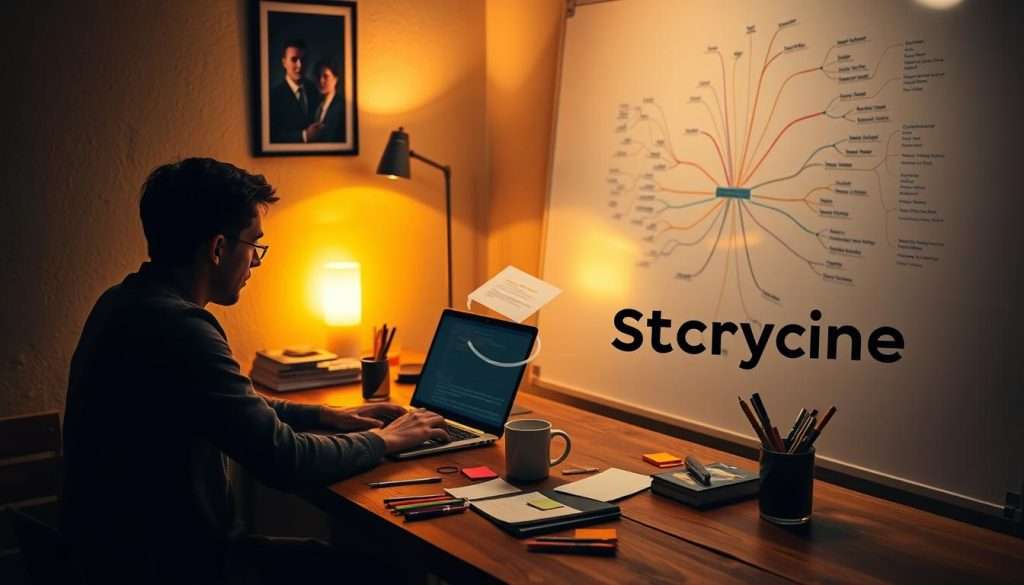Ready to unlock your full creative potential? We have a powerful tool to share with you: mind mapping. This visual representation of ideas connected to a central concept is a game-changer for brainstorming, note-taking, and project planning.
By using mind mapping, you can boost your productivity and take your creative thinking to the next level. It’s a simple yet effective way to organize your thoughts, identify patterns, and make connections between seemingly unrelated ideas.
Key Takeaways
- Unlock your creative potential with mind mapping
- Boost productivity through visual brainstorming
- Improve note-taking and project planning
- Make connections between seemingly unrelated ideas
- Enhance your overall creative thinking
The Science and Psychology of Visual Thinking
Studies show that mind mapping boosts retention and understanding. Our brains handle visuals better than text. This makes mind maps great for learning and creativity.
How Our Brains Process Visual Information
Images are quickly processed by the brain’s visual cortex. This part of the brain can handle lots of info at once. Visual thinking uses this to help us remember and recall info better.
Why Mind Maps Work Better Than Linear Notes
Mind maps are better than linear notes because they match how our brains think. They use a radial, non-linear structure. This helps us see how ideas are connected, improving understanding and memory.
Research on Retention and Comprehension
Research shows visual aids like mind maps can boost retention by up to 65%. The table below highlights some key findings on visual thinking’s effectiveness.
| Study | Method | Retention Rate |
|---|---|---|
| Study 1 | Mind Mapping | 75% |
| Study 2 | Linear Notes | 45% |
| Study 3 | Visual Aids | 90% |
By using visual thinking, we can learn and remember better. Mind maps are a fun, effective way to tap into this power.
Benefits of Mind Mapping for Creative Problem-Solving
Mind mapping lets us see our ideas in a new way. It helps us find new solutions to problems. This method is great for organizing thoughts and sparking creativity.
Breaking Through Mental Blocks
Mental blocks can stop us from thinking creatively. Mind mapping helps by organizing our ideas and making new connections. By starting with a central idea and branching out, we can find new ways to solve problems.
Discovering Unexpected Connections
Mind maps help us find new links between ideas. This process encourages out-of-the-box thinking. As we map out our ideas, we see how different parts work together, leading to new solutions.
Enhancing Memory and Recall
Mind maps also boost our memory. By using images and colors, we remember information better. This is especially helpful for complex problems that need lots of details. Mind mapping makes it easier to remember and solve problems.
Core Elements of Effective Mind Maps
To get the most out of mind maps, knowing the key elements is crucial. These elements boost creativity, organization, and memory. They work together to make mind maps effective.
Central Themes and Radial Structure
Every mind map starts with a central theme or main idea. This idea is surrounded by a radial structure. The structure has branches that spread out, showing your thoughts and ideas clearly.
Keywords and Brief Phrases
Mind maps use keywords and brief phrases to share information quickly. They help you quickly understand the main points and how they connect.
Colors, Images, and Visual Cues
make mind maps stand out and stick in your memory. They help show different ideas and add personal touches.
The Importance of Personal Meaning
Using personal symbols and colors makes your mind map more meaningful. It makes the information easier to remember. When you add personal touches, you’re more likely to recall the details.
Step-by-Step Guide to Creating Your First Mind Map
Creating your first mind map is an exciting step towards unlocking your creative potential. Mind mapping is a powerful visual thinking tool. It helps you brainstorm, organize, and connect your ideas in a non-linear way.
Gathering Your Materials
To start, you’ll need a few simple materials. You can use traditional tools like paper and colored pens or digital tools like mind mapping software. Choose a medium that feels comfortable for you. Select a large sheet of paper or a digital canvas that gives you enough space to expand your ideas.

Defining Your Central Topic
The central topic is the heart of your mind map. It represents the main idea or theme you want to explore. Choose a topic that is meaningful and relevant to you. Write it down in the center of your map, using a symbol or image that represents your topic.
Building Primary Branches
Once you have your central topic, it’s time to add the primary branches. These branches represent the main categories or themes related to your central idea. Use different colors for each branch to create visual distinction and make your map more engaging.
Adding Secondary Connections
After establishing your primary branches, you can add secondary connections. These sub-branches help to further develop your ideas and create a richer map. Use keywords and short phrases to keep your map concise and easy to read.
Practical Exercise: Your First 10-Minute Map
Now, let’s put these steps into practice! Set a timer for 10 minutes and create your first mind map. Start with a central topic, add primary branches, and then secondary connections. Don’t worry about perfection – this is about having fun and exploring your creativity.
As Tony Buzan, the pioneer of mind mapping, once said,
“A mind map is a visual representation of your thoughts, ideas, and information that can help you to organize, analyze, and connect your ideas.”
Take this practical exercise as an opportunity to experience the power of mind mapping firsthand.
Mind Mapping Techniques for Different Thinking Styles
Mind mapping isn’t for everyone in the same way. It fits many thinking styles, helping with creative problem-solving. Since people think differently, mind mapping is very powerful.
Radial Mapping for Creative Thinkers
Radial mapping is great for creative thinkers. It starts with a central idea and spreads out. It uses colors, images, and keywords to spark imagination and explore new ideas.
Tony Buzan, the mind mapping pioneer, said,
“A mind map is a visual representation of your thoughts, ideas, and information.”
This method lets creative thinkers freely associate and come up with ideas.
Hierarchical Mapping for Structured Thinkers
Structured thinkers like hierarchical mapping. It organizes information in a logical way. This makes complex information easier to handle and understand.
By using a hierarchical structure, you can create a clear and concise mind map that shows your structured thinking.
Concept Mapping for Analytical Thinkers
Analytical thinkers enjoy concept mapping. It shows how different ideas are connected. This helps understand complex systems better.
As we explore mind mapping, concept mapping is especially good for analyzing and evaluating information.
Finding Your Personal Mapping Style
The secret to great mind mapping is finding what works for you. Try radial, hierarchical, and concept mapping to see what fits your style. This way, you’ll get the most out of mind mapping and improve your problem-solving skills.
Digital vs. Traditional Mind Mapping Approaches
Mind mapping can be done in two main ways: digitally or traditionally. Each method has its own benefits. It’s important to think about what works best for you, the task, and the advantages of each.
The Tactile Benefits of Hand-Drawn Maps
Hand-drawn mind maps offer a tactile experience that many find engaging. The act of drawing can stimulate the brain and help you connect more deeply with the material. Key benefits include:
- Increased creativity through freehand drawing
- Better retention due to the physical act of writing
- No need for electronic devices or software
The Flexibility of Digital Mind Mapping Tools
Digital mind mapping tools, on the other hand, offer flexibility and convenience. They make it easy to edit, share, and collaborate. Some advantages include:
- Easy rearrangement of map elements
- Real-time collaboration with others
- Access to a wide range of templates and tools

When to Use Each Approach
Choosing between digital and traditional mind mapping depends on your needs. Traditional methods are great for brainstorming or when you need to be very creative. Digital tools are better for projects that need collaboration or frequent updates.
Essential Mind Mapping Tools and Software
To unlock the full potential of mind mapping, you need the right tools. There are many options, from free resources to premium software and mobile apps. Find what works best for you.
Free Mind Mapping Resources
For those on a budget, there are great free mind mapping tools. MindMeister and Coggle are popular choices. They offer intuitive interfaces and collaborative features. They’re perfect for students and professionals who want to organize their thoughts without spending money.
Premium Software Options
If you need more advanced features, consider premium software like MindManager and XMind. These tools have enhanced functionality, including Gantt charts and project management integrations. They’re ideal for complex projects.
Mobile Apps for On-the-Go Mapping
Mind mapping isn’t just for your desktop. Mobile apps like MindNode and SimpleMind let you create and edit mind maps on your smartphone or tablet. They’re great for capturing ideas anywhere.
Comparison of Top Tools
- MindMeister: Great for collaboration, user-friendly interface.
- XMind: Offers advanced features like Gantt charts and SWOT analysis.
- SimpleMind: Excellent for mobile use, intuitive and easy to navigate.
When choosing a mind mapping tool, think about what you need. Do you want collaboration features or advanced project management capabilities? By comparing the top tools, you can find the perfect fit for your workflow.
Practical Applications of Mind Mapping
Mind mapping has many uses, from note-taking to brainstorming. It’s a flexible tool that boosts productivity and creativity in many areas.
Note-Taking and Study Strategies
Mind mapping is great for taking notes and studying. It helps students organize information visually. This makes it easier to remember and recall later. Key benefits include:
- Improved retention through visual cues
- Enhanced organization of complex information
- Better review and study sessions
Project Planning and Management
In project planning, mind maps help teams see the big picture. They show the scope, timelines, and tasks. This makes teamwork and project success easier. Key advantages include:
- Clear visualization of project components
- Simplified task assignment and tracking
- Enhanced team communication
Brainstorming and Idea Generation
Mind mapping is excellent for brainstorming and coming up with new ideas. It lets people and teams explore ideas freely. This boosts creativity. Benefits include:
- Unstructured idea generation
- Identification of novel connections
- Enhanced creative problem-solving
Problem-Solving Frameworks
Mind maps can also help solve problems. They break down complex issues into simple parts. This makes it easier to analyze and solve problems. Key aspects include:
- Decomposition of complex problems
- Visualization of potential solutions
- Evaluation of solution effectiveness
Using mind mapping in these ways can greatly improve productivity and creativity for individuals and teams.
Advanced Mind Mapping Strategies
To unlock the full potential of mind mapping, we’ll explore advanced strategies. These include creating mind map systems and integrating them with other productivity techniques. As you get better at the basics, these advanced methods will help you handle complex projects with ease.
Creating Mind Map Systems
Creating a mind map system means making a network of maps that work together. This is great for big projects that need lots of planning. By linking maps, you can easily navigate through complex information.
Start by identifying the central theme or project you want to map out. Then, create a primary mind map that acts as the hub. From there, create maps that branch off. This structure helps manage detailed info without cluttering your main map.
Integrating with Other Productivity Methods
Mind mapping works best when combined with other productivity techniques. For example, using it with the Pomodoro Technique can improve your focus.
You can also link mind maps with to-do lists or project management tools. This helps you see your tasks and deadlines clearly. It makes it easier to prioritize and manage your time.
Using Templates for Consistent Results
Templates can make your mind mapping faster, especially for similar projects. By using a standard template, you save time and ensure consistency.
Make templates for tasks like project planning, meeting notes, or brainstorming sessions. This speeds up your mapping and keeps your maps looking the same.
Case Study: Mind Mapping for Complex Projects
A marketing team used advanced mind mapping for a product launch. They made a central map for the project and separate maps for market research, content, and distribution.
This way, they could see the whole project and manage details in sub-maps. The team said it improved their collaboration and understanding of their roles.
Troubleshooting Common Mind Mapping Challenges
When we start mind mapping, we often face obstacles. Whether you’re a student, a professional, or just curious, you’ll hit roadblocks. Here, we’ll tackle common issues and share tips to get past them.
Dealing with Complex Topics
Complex topics can feel overwhelming. But mind mapping can simplify them. Start by breaking down the core components. Use keywords and brief phrases to capture each element’s essence. Different colors or symbols can help distinguish between aspects.
Managing Information Overload
Information overload is a big challenge in mind mapping. Focus on the key information and filter out the rest. Use a hierarchical structure to organize your map, prioritizing the most important details. You can also split large maps into smaller, connected ones.
| Challenge | Solution |
|---|---|
| Complex Topics | Break down into smaller components, use keywords, and differentiate with colors or symbols. |
| Information Overload | Focus on key information, use a hierarchical structure, and break down into smaller maps. |
Refining Your Personal Mapping Style
Your mind mapping style is unique. It evolves over time. Try different layouts, colors, and images. Tony Buzan said, “The key to successful mind mapping is to use keywords and images.” Experiment to find what works best for you.
“A mind map is a diagram used to visually organize information. A mind map is often created around a single concept, drawn as an image in the center of a blank page, to which associated representations of ideas such as images, words, and parts of words are added.” – Tony Buzan
When Mind Mapping Isn’t Working
At times, mind mapping doesn’t click. If you’re stuck, take a break and rethink your approach. Ask if you’re using the right tools or if another method might work better. Don’t hesitate to change your approach or try something new.
Conclusion: Transform Your Thinking Through Mind Mapping
We’ve looked into mind mapping, and it’s a real game-changer. This visual technique can unlock your creativity, boost your productivity, and solve complex problems easily.
Mind mapping brings many benefits. It improves your creativity and productivity and helps with problem-solving and learning. Good mind maps use central themes, keywords, and visuals to make learning fun and informative.
Now, it’s your turn to start using mind maps! Whether you’re a student, a professional, or just someone who loves to learn, give it a try. With practice, you’ll see how visualizing your ideas can change your thinking.
Using mind maps will show you the benefits right away. You’ll see problems from new angles, make hidden connections, and reach your goals faster. So, grab a pen, paper, or your favorite digital tool, and start mapping your way to success!

